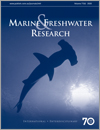
Marine and Freshwater Research
Volume 71 Number 6 2020
MFv71n6_OBObituary: Dr Julia Howitt
Fish mortality through floodplain pumping stations is a recognised global issue, but few studies have quantified the impact of such infrastructure. This study aimed to use passive acoustic monitoring to record and identify the sounds generated when fish move through pumping stations. It is envisaged that this tool has application not only in quantifying eel mortality, but also as an early detection tool to illicit and test an appropriate management response.
MF18422Eutrophication in the Neva Estuary (Baltic Sea): response to temperature and precipitation patterns
Weather variables affect eutrophication indicators in estuaries. We tested the hypothesis that cool and rainy weather in midsummer has a stronger stimulatory effect on indicators of eutrophication in the Neva Estuary than warm weather. The analysis showed that total phosphorus and chlorophyll concentrations and primary production in the estuary were positively correlated with the amount of precipitation and the number of rainy days in the region.
The reproductive strategy of the small-spotted catshark was studied based on both macroscopic and microscopic observations of the reproductive tract in 2253 individuals sampled as bycatch in Hellenic waters (eastern Mediterranean Sea). The species exhibited a K-selective strategy, and information regarding its reproductive period, size at maturity, fecundity, morphometrics of oocytes and egg cases and somatic indices is presented and discussed.
MF19055Bioaccumulation and health risk assessment of polycyclic aromatic hydrocarbons in oyster (Crassostrea sp.) and gastropod (Cymatium sp.) species from the Can Gio Coastal Wetland in Vietnam
This study provides information on the bioaccumulation and potential health risks of polycyclic aromatic hydrocarbons (PAHs) in oysters and gastropods collected from the Can Gio Coastal Wetland, Vietnam. The results indicate that both oysters and gastropods contained PAHs, especially those collected from port sites, but there is no current risk to humans due to oyster and gastropod consumption.
MF19191Shark longline fishery of Papua New Guinea: size and species composition and spatial variation of the catches
Detailed size and sex compositions were obtained from catches of the shark longline fishery in Papua New Guinea. Silky sharks were the dominant shark caught in this fishery, constituting more than 90% of the catches. Misidentifications of species by observers was low (~10%) reflecting the use of regional identification guides and observers who are well trained.
MF18449Seasonal variations in plankton trophic structure under highly eutrophic conditions
The plankton trophic structure determines how efficiently energy is transferred through aquatic food webs. We evaluated the seasonal dynamics of phytoplankton, microzooplankton and mesozooplankton in a well-mixed, highly polluted tropical estuary and, based on their interactions, proposed a conceptual trophic model for the plankton community. Rainfall is the most important environmental variable in this system and microzooplankton play a key role in its food web.
MF19138Latitudinal variation in growth rates and limited movement patterns revealed for east-coast snapper Chrysophrys auratus through long-term cooperative-tagging programs
Analysis of a long-term tag–recapture dataset for Australian east-coast snapper (Chrysophrys auratus) indicated they are largely resident on a decadal time scale and at reasonably small spatial scales. However, the population exhibited ‘partial migration’, whereby a small percentage of fish moved considerable distances (up to 1000 km). Growth rates of recaptured fish were affected by latitude, with higher growth rates at lower (more northern) latitudes.
MF19095Predation on eggs of the apple snail Pomacea dolioides (Reeve, 1856) in rural and urban areas of the Amazon
Populations of the apple snail Pomacea dolioides are more affected by egg predation in rural areas of the Amazon than in urban areas. In urban areas, it is likely that human action and subsequent changes in the natural environment are favouring the reproductive success of P. dolioides by reducing egg predation. The main predators of the eggs of P. dolioides were the ants Solenopsis invicta and Crematogaster cf. carinata.
MF19100Reproductive dynamics, age and growth of Astyanax aff. fasciatus in a Neotropical basin
Population dynamics provide crucial information for management and conservation. In this study we analysed the spatiotemporal patterns in reproductive biology, age and growth of Astyanax aff. fasciatus from a Neotropical river affected by human activities. The reproductive behaviour of the species was not homogeneous along the river due to geomorphology and human activities in surrounding areas, with some sites becoming unavailable for breeding.
MF19066Teleost community composition and the role of herbivory on the intertidal reef of a small isolated island in north-west Australia

We sampled fish and evaluated herbivory on the reef platform at Browse Island, 200 km off north-western Australia. We found 99 fish species, 18 of which are known to eat turf, but only 4 that eat macroalgae. Fish were eating turf on the reef, but we found no evidence they were eating macroalgae. This may make the reef more vulnerable to overgrowth of algae in the future.
MF18487Lethal and sublethal effects of simultaneous exposure to hypoxia and aluminium on juvenile eastern school prawn
The survival of eastern school prawn increased significantly with increasing dissolved oxygen concentrations. Total fatty acid and amino acid concentrations were significantly greater in prawns subjected to hypoxia, regardless of aluminium exposure, with differences in fatty acid and amino acid profiles attributed to docosahexaenoic acid, stearic acid, palmitic acid and behenic acid (fatty acids) and leucine, isoleucine, phenylalanine and asparagine (amino acids).
MF19029Evidence of site fidelity and deep diving behaviour of scalloped hammerhead shark (Sphyrna lewini) around the Saint Peter and Saint Paul Archipelago, in the equatorial Mid-Atlantic ridge
Using satellite telemetry, this paper unravels aspects of the horizontal and vertical movements of scalloped hammerhead sharks (Sphyrna lewini) for the first time in the equatorial and south Atlantic Ocean and helps fill the gap on the species’ ecology.



